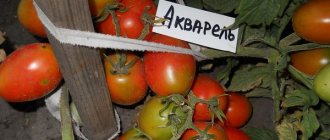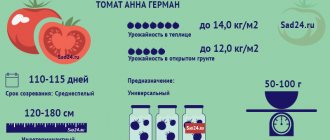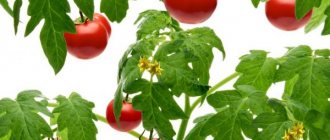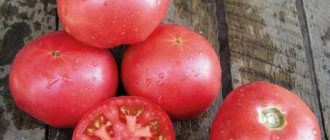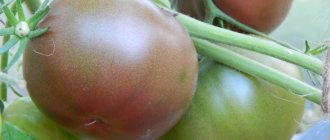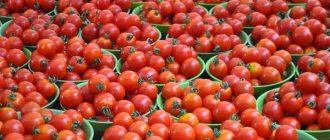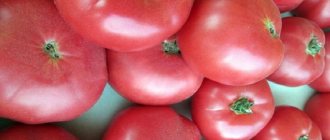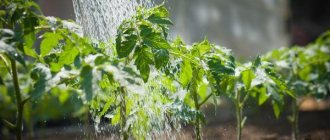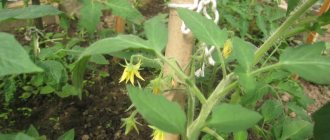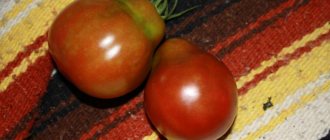Tomato Sanka, the characteristics and description of the variety presented in our article, is ultra-early. It will be a real boon for gardeners who want to harvest delicious tomatoes on their plot as early as possible.
The tomato variety Sanka was developed in 2003 by Russian breeder E.N. Korbinskaya. Gives high yields in open ground in the Central Black Earth region. In Siberia, you can get an early harvest of the Sanka variety by growing these tomatoes in greenhouses or under temporary shelter.
general description
The Sanka tomato is a determinate tomato variety, which makes it popular for creating outdoor vegetable beds. Having reached a height of 60-70 centimeters, the plant stops producing flower clusters.
As it develops, the bush gradually and very densely becomes overgrown with medium-sized leaves. Among the features of the themed red vegetable are also:
- Early harvesting - 75-100 days from germination;
- Unpretentiousness - resistance to cold, shade, diseases;
- Short stature - about 70 cm;
- Early formation of the ovary - after the 7th leaf;
- High yield volume - 2.5 kg per bush;
- Presentation – fruit weight is about 100 g.
No less delightful are the ripened Sanka tomatoes, the description of which is worthy of the following words - roundness, keeping quality, balanced level of sucrose and acids. One bush produces up to 40 scarlet round logs. And this without the need for a garter.
It is possible that the yield can be improved through closed soil. But the latter is more suitable for tall counterparts.
Sanka tomatoes - growing conditions
The culture is characterized by excellent germination, its friendliness, and ease of care. Having decided to grow a Sanka tomato, study the description of the important conditions under which you will get a good harvest.
- You should purchase seedlings from trusted places. This is the key to its quality and good survival rate. You can prepare it yourself from the current year’s harvest.
- When growing seedlings, it is necessary to water them regularly, protect them from drafts, provide additional light through fluorescent lamps, prevent diseases and pests, and feed them.
- It is recommended to plant tomatoes of the Sanka variety in a permanent place when two leaves appear on the seedlings.
- You should not grow tomatoes in areas where potatoes, eggplants, and peppers were previously cultivated. Good predecessors for them are pumpkin and legumes.
Sowing seeds
The hero of the topic is not a hybrid. Grown by seedlings. It is recommended to sow Sanka seeds 2 months before planting seedlings in open ground. Mostly seeds are planted in mid-March.
But if the region is southern, planting can be done in the first week of spring. In addition to seeds, sowing will require:
- Container 6 cm deep - box or seedling cassettes;
- Nutritious loose soil - ready-made store-bought soil or a mixture of peat and ash (4:1).
Typically, one pack of tomato contains 10-50 seeds. For them, a box with an area of 20x30 cm or the corresponding number of seedling cassettes is sufficient. One seed must be planted in one cassette.
Advantages and disadvantages
According to responses from gardeners, the Sanka tomato is endowed with a large number of positive qualities. The advantages of the variety include:
- precocity;
- increased productivity;
- long fruiting;
- taste qualities;
- good transportation;
- frost resistance;
- collection of seed material.
The advantages of the variety also include good immunity to various diseases and insect pests.
As practice has shown, the Sanka tomato has no shortcomings. However, in order to get a decent harvest, you will need to follow certain rules of agricultural technology and care.
Systematic watering and fertilizing
Red nightshade vegetable is quite moisture-loving. But this does not mean that it needs to be watered often. At an early stage of tomato development, spraying should be completely abandoned. It's better to limit yourself to:
- Watering - 1.5-2 times a week (as the top layer of soil dries);
- Feeding with nitrogen-phosphorus or complex fertilizer - on the 2nd week after germination and a week before planting in open ground.
If these rules and schedule are neglected, the seedlings will quickly become sick with blackleg or late blight due to the fungus.
Moreover, one must understand that the latter is facilitated not only by a high level of moisture, but also by poor daylight hours (less than 10 hours) and drafts. Therefore, it is recommended to start growing tomato seedlings in early spring, when daylight hours increase.
Advantages and disadvantages of the variety
This variety of tomato immediately became popular, and today it has won many fans.
- Resistant to almost all harmful diseases.
- It can bear fruit all summer long, and due to its resistance to low temperatures it can continue to produce fruits right up to frost.
- The fruits are very beautiful and tasty.
- Does not require stepsoning.
- Early fruit ripening.
- The bushes grow without support; no garter is needed.
Having bought seeds once and grown tomatoes, you don’t have to worry about purchasing seeds; the variety is not a hybrid, so you can prepare the material for planting yourself.
Typically, manufacturers are reluctant to indicate shortcomings and place on the label only praise from gardeners and the advantages of the variety. To understand what shortcomings it has, I had to study the reviews on the forums in detail.
Indeed, many gardeners are happy with these varieties. But there are also several gardeners whose experience of growing this tomato has become negative.
- Some summer residents claim that the bush actually bore fruit for a very long time, but the fruits were not very large. Even less than stated on the seed label. In this case, the tomato most likely did not like the soil in which it was planted or the plants were improperly cared for.
- Some gardeners claim that Sanka still suffered from late blight. Although the description of the variety indicates that “Sanka” is immune to all diseases.
As you can see, everything is individual, and to understand whether you really like this variety, you need to plant several bushes for testing and harvest. And then draw conclusions.
Hardening of seedlings
Although the hero of the topic is a cold-resistant tomato, it would not be superfluous to harden off its seedlings.
It is carried out as follows: the nursery is exposed to a temperature low compared to room conditions for 2-3 hours. The difference between the room temperature and the outside temperature should not exceed 6 °C.
The ideal place for removal is a veranda or balcony. Gradually, the stressful time for the tomato can be extended by 2 hours up to 12 hours a day.
Reviews
Larisa 47 years old
We have been planting the varieties “Sanka” and “Sanka Zolotoy” for 5 years now, they practically do not differ in care, and the taste of both is excellent. Small-sized tomatoes fit perfectly into jars, which makes it possible to close a kind of assortment; by the way, they look very beautiful; you can’t buy something like that in a store. The grandchildren are simply delighted with “Sanka the Golden”; they eat tomatoes instead of fruits, well, if only for vitamins. I also freeze them in slices for the winter, then add them to various dishes. I'm satisfied with the variety.
Gennady 65 years old
“Sanka Golden” was planted for the first time that year, the harvest was good and the taste was excellent. Unlike many varieties, it is not fussy to care for. You can cut it, add herbs, add salt, and you get a very tasty and juicy salad. My wife pickled several three-liter jars for the winter; they were the first to eat out of all the preserves; they turned out to be very tasty tomatoes.
Growing in open ground
It is clear that Sanka tomatoes, a description of the variety, deserves separate lines about open-air agricultural technology. “Adult life” begins 30-45 days from the moment the shoots appear.
The young plant should grow to a minimum of 18 cm and even begin to form buds. Before the latter have opened, it is recommended to replant the tomato:
- Weed killer Tornado: detailed instructions for using the herbicide, photos, diagrams, description
Feeding tomatoes after planting in the greenhouse: step-by-step instructions, with photos and descriptions
Cucumber seedlings - how to properly prepare soil for seedlings and sow cucumbers at home
- A well-lit place without a high groundwater level is selected;
- The soil for the beds is cultivated - holes are created for tomatoes with a depth of 20-30 cm;
- Peat, sand, humus-compost, ash (3:1:1:1) are added to the holes;
- The bushes go deep into the soil over the root system almost to the very bottom branches so that the roots grow better;
- The finished beds are watered with the Kornevin solution.
The optimal distance between low-growing bushes in one row is 40 cm, between rows - 0.8-1.0 m.
It is better to plant seedlings in clear, windless weather. Since frost may occur at night, it is recommended to cover the tomato with film until June.
A week after planting the bushes, the latter can be sprayed with the biofungicide “Fitosporin M” and the bioinsecticide “Fitoverm” to prevent late blight and harmful insects, respectively.
The emphasis on biological fungicide and insecticide was made for a reason, since the corresponding preparations are environmentally friendly and do not harm beneficial insects that contribute to pollination.
How to care for Sanka tomatoes?
Following a number of important recommendations will allow you to get a good harvest. Having planted Sanka tomatoes, provide them with care consisting of the following aspects:
- Watering
. The soil should be evenly but moderately moistened. Cold water should not be used; its temperature should be slightly above room temperature. When watering, avoid getting moisture on the tomatoes and leaves. - Eliminating weeds, weeding the soil
. Describing what a Sanka tomato is, their characteristics said that they love loose soil. - Fertilizer
. Use organic compounds, such as manure solution. It is not recommended to use industrial fertilizers, because the fruits can accumulate nitrates. - Garter
. More often there is no need for it, because Sanka tomatoes have low-growing bushes. If the crop produces large fruits, they can bend the branches towards the ground. In this case, a garter is required. - Pest control
. Pest control plays an important role in crop care. The dangerous “enemy” of tomatoes of this variety is the Colorado potato beetle. To combat it and other possible pests, insecticidal preparations are used (Commander, Bombardier, Trichopolum, Fitosporin). - Disease Control
.
Tomatoes of this variety have good immunity to many diseases, but there are some that can affect the crop:
- Late blight
. With it, the fruits and leaves of the crop become covered with spots that form due to temperature changes or excessive moisture. You can fight late blight with a solution of boric acid or fungicides (Previkur, Infinito, Quadris). - Alternaria blight
. The disease manifests itself as a black coating on tomatoes, spots covering the leaves. Fungicides (Sectin, Bravo) are used for treatment. - Black leg
. During the disease, the near-ground part of the stem dries out due to excessive watering and poor ventilation. Prevention of the disease is to water the plant with a weakly concentrated solution of manganese. - Fungal diseases
. They manifest themselves in the formation of black spots covering the entire culture. To eliminate the problem, you need to use preparations containing copper, such as Agat-25, Tatu.
When and what to feed Sanka tomatoes?
This process is carried out during the beginning of flowering. Everyone who grows Sanka tomatoes should know their characteristics and need to know what to feed the crop with. She does not need mineral compounds at this time. Fertilizing can be done with a humus solution, diluting it with liquid in a ratio of 1:5. Chicken manure, which is diluted in a ratio of 1:15, is also suitable.
Is it necessary to plant Sanka tomatoes?
This procedure may be required by the culture. Those growing this variety may wonder how to shape Sanka tomatoes? If the plant is tall, it is carried out in a pair of stems followed by pinching. This process involves removing excess shoots that form on the bush. Thanks to it, the thickening of the planting is reduced. It is important to leave the growing tip. Stepchildren whose length is less than 5 cm cannot be removed. To perform the procedure, you need to take the shoot with two fingers, pinch it and move it in different directions until it comes off the bush.
Caring for an adult tomato
The target audience likes Sanka tomatoes due to their unpretentiousness.
Firstly, they do not require gartering or pinching. Secondly, good growth and harvest are achieved by simply mulching the soil with straw or freshly cut grass every second week.
Until the bushes begin to bear fruit, it is recommended:
- Adhere to proper watering - 2 times a week, 2-3 liters of warm water for each plant;
- Loosen the soil around the plants to ventilate the root system;
- Destroy weeds;
- Feed the beds with complex mineral solutions - once a month, with the exception of the fruiting period, which excludes the use of enrichment minerals so that the crop contains less nitrates.
When the fruits have set, but have not even begun to turn red, it is recommended to fill the beds once with organic matter - a 5% solution of mullein or humus with the addition of 5% ash.
The latter contains potassium, which is very important during the fruiting period. As a result, there should be three feedings in total within the framework of the development of the hero of the theme in the open ground:
- The first (mineral) - after planting seedlings;
- The second (organic) - at the moment of formation of large fruits;
- The third (organic) – as part of a bountiful harvest.
At the same time, the concentration of mullein humus and ash can be reduced for the last time despite active fruiting. But water consumption during fruiting increases 2-3 times.
2 weeks before harvesting the fruits, you will have to abandon treatment with agents against diseases and insects so as not to poison the crop.
Therefore, it is better to use biological fungicides and insecticides immediately after transplanting seedlings and in extreme cases, when the beds are in trouble.
An alternative to the drug "Fitosporin-M" is "Hom". Instead of “Fitoverma” you can use “Aktara” or “Commander”.
Reviews from gardeners who planted the Sanka variety
Ivan.
I have been planting this variety myself for a very long time. I like that it is frost-resistant and unpretentious. No need to bother with a garter. The fruits themselves have a thin skin and a sweetish flesh. Tomatoes of this variety grow earlier than others in my garden, and we try them after the “wooden” store-bought tomatoes, the difference, as they say, is obvious.
Elena.
For me this is the best tomato. With him, I am always sure that my harvest is blowing. Tomatoes of this variety are suitable for canning and for preparing salads and other dishes. Last year, I harvested the last harvest of this tomato in mid-September and there were still a lot of green tomatoes on the branches. I came up with the ideal landing model for myself. I plant seedlings first in a greenhouse and then in open ground. Neighbors plant directly in the ground under agrofilm. I'm still afraid of this method. The taste of the tomato is also excellent, moderately sour and moderately sweet. In general, the product is what you need.
VIKI271
My opinion about the tomato will be mixed. I will say this: a tomato with features. Comfortable to fit. Unpretentious and frost-resistant. There is just one drawback: I only harvest the fruits of the size stated on the label during the first harvest. Then the tomatoes become smaller. Although there are no complaints about the taste. I use this variety of tomatoes only for canning. He fits here perfectly.
Svetlana
I liked the tomato, it is unpretentious and ripens quickly. I have never been sick before, but my sister caught phytoflora, in general, she was disappointed in the variety.

